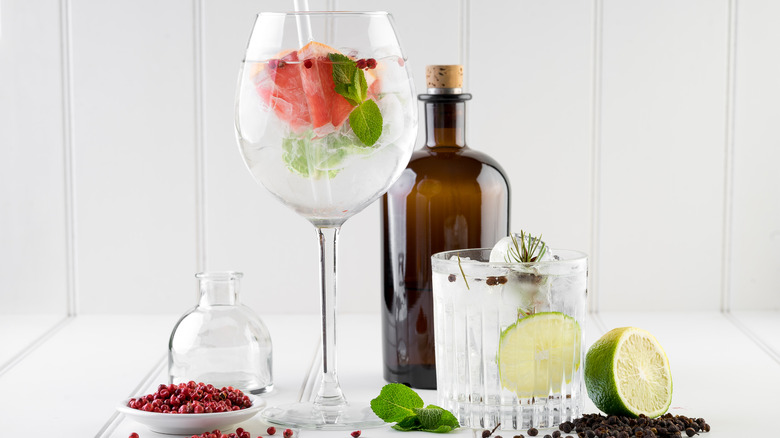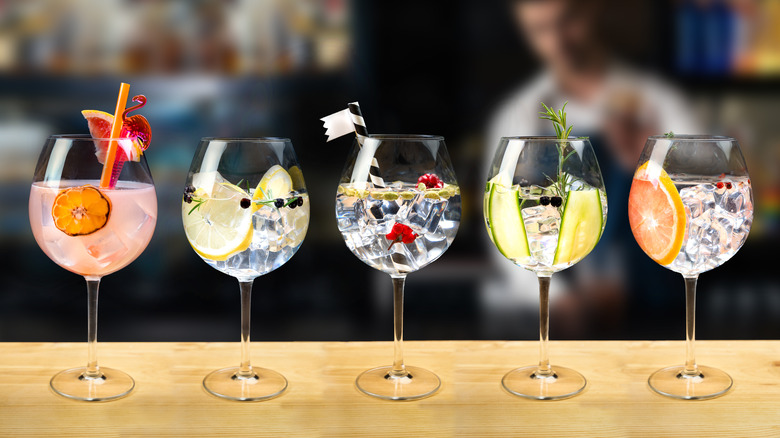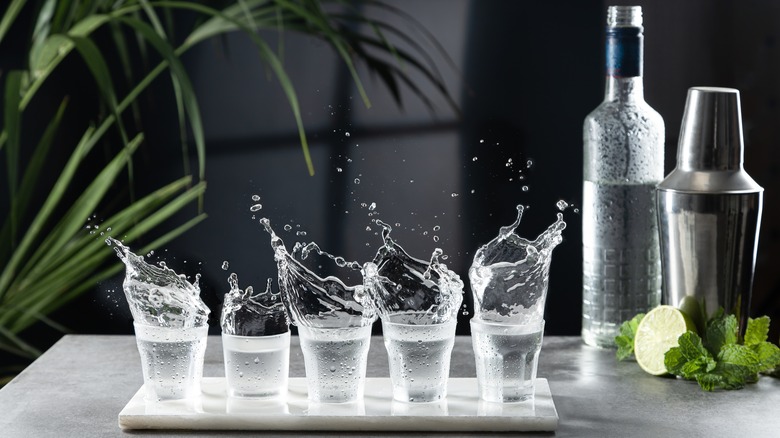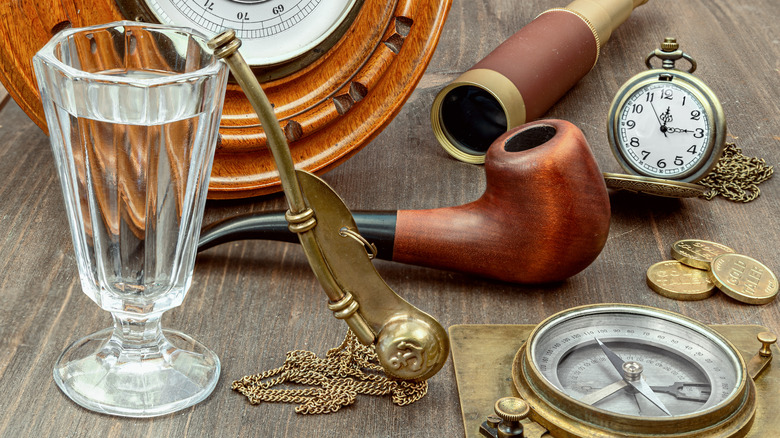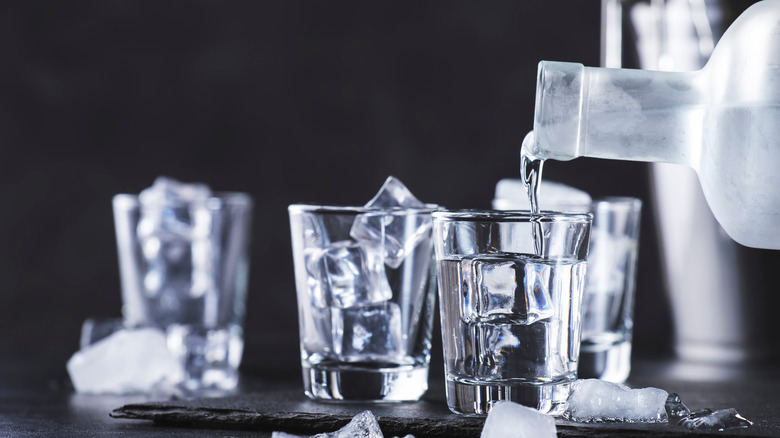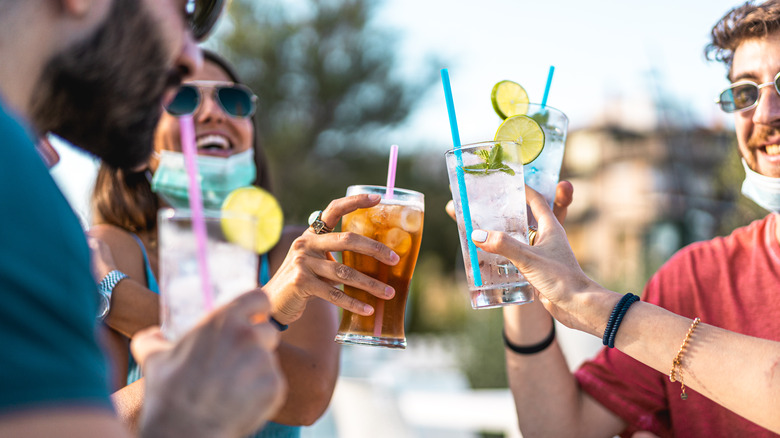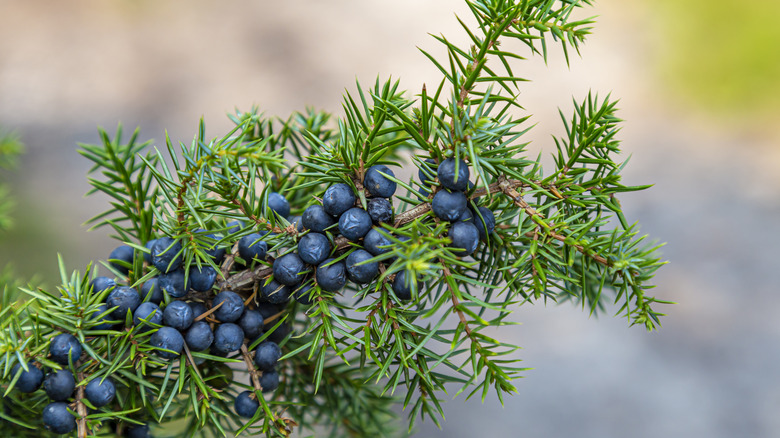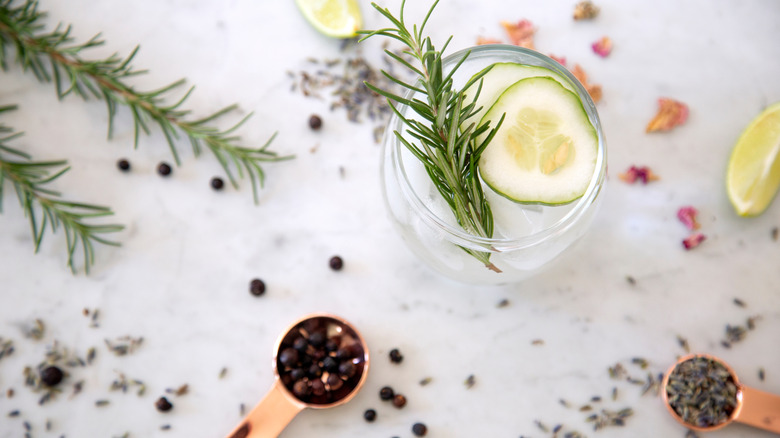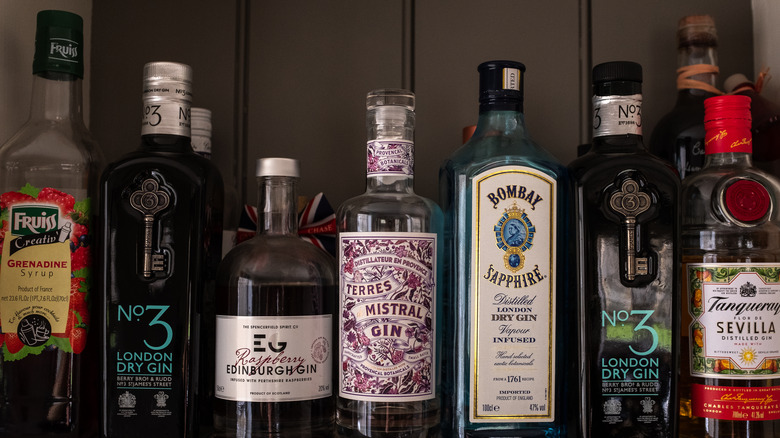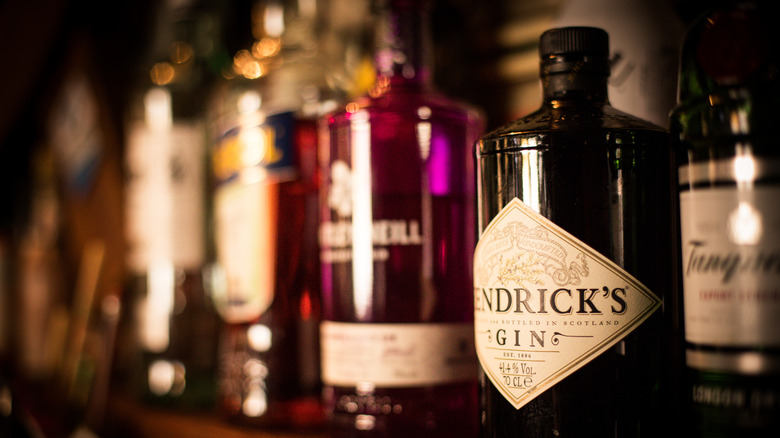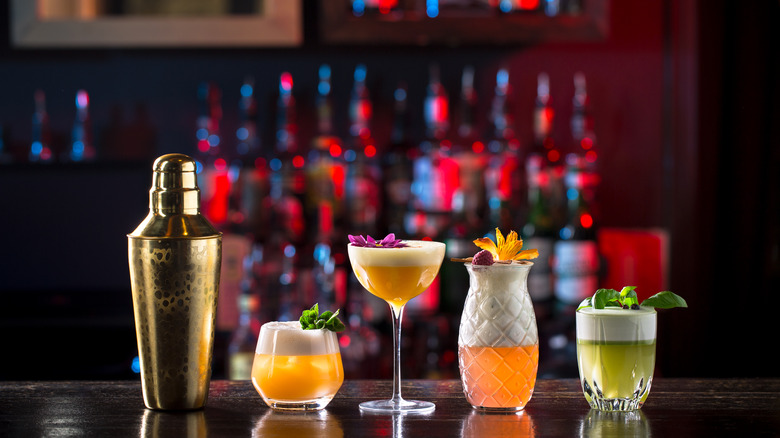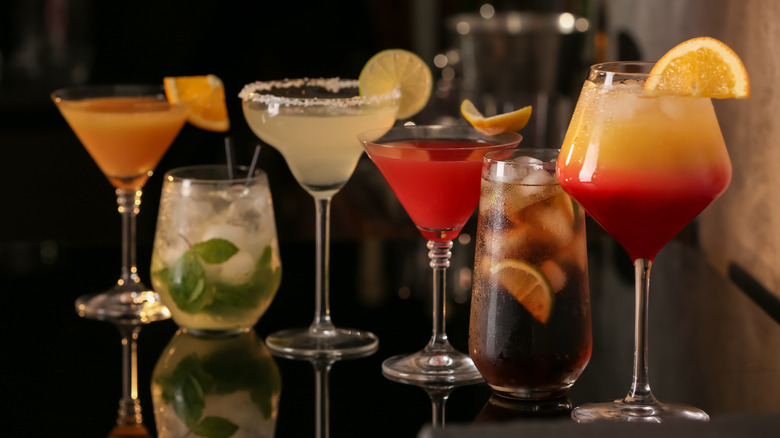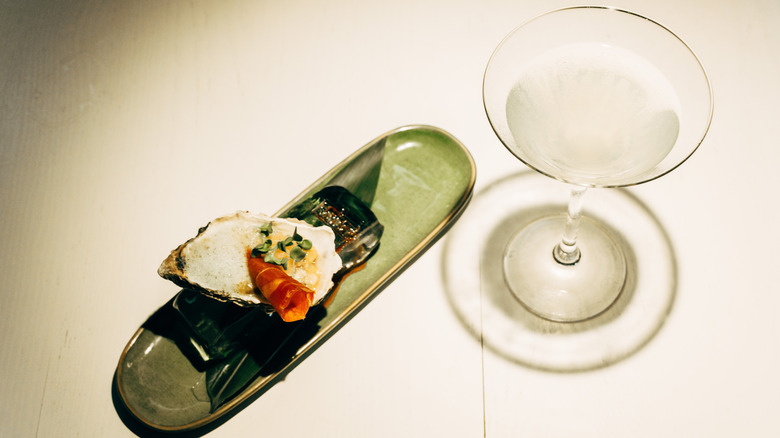13 Mistakes People Make When Drinking Gin
In the wondrously vast world of cocktails, drinks with a gin base are painfully underrated. Many people might even have had less-than-ideal experiences with the juniper-derived spirit from their early drinking days. That can usually be attributed to drinking way too much from a low-quality bottle. Where vodka is often relatively tasteless and can be blended into a mixed drink without a second thought, the complex flavors of gin can make things tricky. But done right, gin takes a cocktail to the next level.
Gin drinks also go far beyond the basic gin and tonic highball or a dirty martini. For one, there are different styles of gin, each made from a specific blend of botanicals and which are more than worth your time and money to explore.
To banish the bad reputation of the spirit, we've taken on some of the most common mistakes people make with gin. This guide will turn you into a much more knowledgeable drinker who can feel confident ordering a gin gimlet at the bar or crafting a negroni at home.
Serving it in the wrong glass
One of the most simple mistakes that you can make when approaching gin for the first time is drinking it out of an incorrect glass. It isn't that there is just a single type of glass that every gin cocktail should be served in, however. Instead, think of this as a set of guidelines, as the vehicles for your gin cocktail should hit a few parameters. Most importantly, drink your gin out of a glass with a large opening. The aromas of gin are almost as integral to the flavor as its taste. A wide-mouthed glass helps your nose catch all of those notes that would otherwise remain hidden.
Aside from martinis, many gin cocktails are also best served with plenty of ice. This means that a glass like a gin balloon, highball, or tumbler is usually the best option. These glasses also allow optimal room for decorative garnishes like large wedges of citrus or sprigs of herbs that further complement the gin's flavor. Copper mugs are also well-suited to keeping frosty gin mules cold, while a coupe can serve as a great alternative to the classic martini glass.
Drinking gin straight without understanding it
The easiest way to make someone hate gin is to make them drink a lukewarm shot of a cheap spirit. It's not that gin can never be enjoyed on its own. However, that only works if you truly know how to approach it. Like most spirits, bad gin will taste bad whether you drink it by itself or in a cocktail. Gin is a neutral spirit that can be made from a variety of bases, such as grains, grapes, or rice. That base can affect the flavor of straight gin almost as much as the botanicals or other additives in a particular recipe.
Gin can taste unappetizing if the botanical blend isn't well balanced. A shot of low-quality vodka might just burn, but a lopsided gin can make your stomach turn. Craft gin is the best to drink straight, especially any bottle made with high-quality juniper to avoid an overly bitter flavor.
As for selecting the best gin to drink straight, try some experimentation. Make a simple gin and tonic with a variety of gins and figure out which botanical elements stand out and taste best. Odds are that you will enjoy drinking a straight gin the most if it plays well in such a classic and streamlined mix. A bit of trial and error can help you avoid an unsavory shot.
Ignoring the history of gin
It's much easier to like something when you understand its history. Gin has been around for centuries and has undergone quite an evolution. An early iteration of gin called genever was made in the Netherlands for medicinal uses, but it was more like schnapps. Gin as we know it today became especially popular in 17th-century Britain, which is perhaps why many people misunderstood believe that Britain created the liquor. In fact, British soldiers were drinking Dutch genever during the 17th-century Thirty Years' War, but at the time it was a malt and neutral spirit base with none of those magic botanicals it's known for today.
Gin was such a staple in British households in the 1700s that nearly everyone was distilling it at home. As the British empire expanded, so did the reach of gin. The first gin and tonics were created in India to help British soldiers ward off malaria, as tonic contains quinine that may prevent disease. In the U.S., the 1900s saw the birth of classic cocktails still found on bar menus today. Now, gin is made all over the world but London Dry gin remains one of the most popular expressions.
Storing gin at room temperature
The best iterations of most gin cocktails are served ice-cold. That often means adding plenty of cubes to a Tom Collins or making sure your martini glass is icy before pouring your drink inside. Also, take a moment to carefully consider how you store your gin. The high alcohol content of gin makes it stable at room temperature, but it lasts best when stored in a cool place out of direct sunlight, usually between 55 and 60 degrees. This makes a dark cabinet or cool basement the optimal location for stashing your gin.
However, some people prefer to store their gin in the fridge or the freezer, as the high ABV will also prevent the liquid from freezing. The freezing temperatures also help to lessen the strength of alcohol on your palate which means it'll be even more effortless to down your drink before it gets too warm.
If you're still not convinced, London's legendary Duke Hotel is known for storing gin in the freezer to make its world-renowned martini. Try this trick at home to see the difference.
Using a straw for gin cocktails
It might be controversial for those who enjoy sipping on cocktails to forgo their usual straw, but some experts say it's the best way to enjoy any gin-based drink. The wide-mouth glasses meant for many gin cocktails help your nose absorb the aromas of the spirit, but sipping from a straw can diminish the full sensory experience.
Bombay Sapphire's Senior Ambassador Sam Carter told Insider that the brand believes that the smell has such an important impact on the taste that it's banned straws from its drinks. Sure, there's a sustainability element to not using straws, but using one also puts your nose much further away from the glass than if you were sipping directly from the vessel. It's best to save yourself the added effort of buying straws by forgetting them entirely for gin drinks. And don't even get us started on the tiny black cocktail straws that serve little function aside from stirring your drink as you sip.
Under-appreciating the juniper base
It's simpler to learn to like gin if you truly appreciate what it's made from. As such, juniper is the key ingredient here. In fact, it's the one ingredient that is widely required by law to be part of the distillation process for the spirit to be labeled as gin. Juniper berries are small, dark, and marked by a bitter flavor. Juniper can be a fickle plant to cultivate, meaning its growth has declined in England and beyond. Regardless, the crop is pivotal to distilling gin, although juniper berries are also sometimes used in British baking recipes.
Aside from providing gin with its distinct botanical flavor, juniper berries have also long been believed to possess important medicinal properties. The ancient Egyptians used to believe that the berry was a cure for nasty tapeworm infestations, while ancient Greek Olympians would snack on the berries in the hole that it would improve their endurance.
Avoiding gin due to past bad experiences
One of the most common excuses people give for hating gin is that they attribute the spirit to previous bad drinking experiences. Because gin is so fragrant and its flavors and aromas so complex, the simple smell or taste of the juniper can be enough to elicit memories of nights out gone wrong. The bitterness of the juniper can likewise be offputting at first, but it adds to the complex flavor of the spirit that's well worth appreciating. Additionally, if the bitter quality of gin isn't your particular favorite, you should avoid drinks like a negroni or gin and tonic that include other bitter ingredients.
There are other aspects of the spirit's reputation to overcome. Since its peak in the 1700s in Great Britain, gin has been associated with excessive drinking. Some people may also believe that gin, as opposed to other spirits, will make them sad or angry.
That's no more true for gin than any other liquor, however. Realistically, gin is essentially just a more flavorful version of vodka, so it should have a similar effect. The key to drinking anything, gin included, is moderation and hydration. You're also best off exploring different gin-based cocktails to find a particular flavor profile that you fancy.
Underestimating the botanical elements of gin
We keep mentioning gin botanicals but that might be a foreign concept to a novice gin drinker. If the word "botanicals" also sounds vague, well, it's supposed to. Gin can be infused with a wide variety of elements to amp up its flavor, including herbs, fruits, spices, flowers, and other types of vegetation. A bottle of gin can contain dozens of botanicals, depending on its recipe, while others are simpler. The average bottle contains between 10 and 20 different botanical ingredients, though of course, all contain juniper.
The botanical infusions in gin are what makes it especially fun to explore. Many gins will have similar botanicals, with popular ingredients that include coriander, cassis, cinnamon, and citrus peels. Other common additions include angelica root, almond, cardamon, cubeb berries, and many more. Anyone who is looking to learn to love gin should take note of which of these botanicals light up their palate and continue to taste similar expressions.
Not learning about the different types of gin
As with many types of spirits, gin can be broken down into a few key categories. Some, like London Dry, are more popular than others, like aged Reserve gin. The style is a result of a variety of factors, including distillation methods, origin, and alcohol content. London Dry gin, contrary to popular belief, doesn't have to be made in the United Kingdom. Rather, it's a type of 95-proof gin with an ethanol base where the botanicals are only added at the beginning of the distillation process. Other varieties are subject to stricter rules. Plymouth gin, for instance, must originate from the Plymouth Gin Distillery in England, which has been around since the 18th century.
Dry gin is another common variety with no added sugar that is distilled twice. Dry gin distillers have more freedom as to when they add the botanicals to the mix. Old Tom gin is a style with added sugar for sweetness that must contain 37.5% ABV. It's also usually distilled twice, though it doesn't have to be. Other common styles include the more recent Japanese gin and Navy strength gin, which is an over-proofed spirit.
Ignoring flavored gin expressions
We're mentally preparing for the wave of comments that will remind us that all gin is technically flavored, thanks to those lovely botanicals we keep talking about. However, some gin distillers like to infuse other strong flavors into their gin to make it truly stand out compared to a straight expression of the spirit. Hendricks Gin from Scotland is known for releasing some extremely funky expressions of its gin like the honey and floral-infused Flora Adora bottle. Another floral option comes from Glendalough Distillery in Ireland. The brand released a rose gin in honor of the distiller's late mother that was originally infused with flowers from her rose garden. That theme was also reflected in the spirit's bright pink hue that can bring visual flair to even the simplest cocktails.
Speaking of colorful gins, Blackwell Spirits' McQueen Violet Fog Ultraviolet Edition cones as a royal purple color. The Brazilian spirit is infused with 21 botanicals that include lemongrass, pomelo peel, and jasmine flower for a floral and citrus-forward profile. Another fruity option on the market is Drumshanbo Gunpowder Irish Gin which is infused with California oranges and citrus for a punchy, bright flavor.
Avoiding classic gin cocktails
The classics stay classic for a reason, which is why so many gin cocktails have stood the test of time. As a testament to this, look at the long list of classic cocktails utilizing gin, like the bright-purple Aviation cocktail featuring Maraschino liqueur or the Campari-infused negroni. Gin rickeys, dirty martinis, gin sours — the list goes on.
In the 21st century, many drinkers have opted to swap vodka im for the usual gin to mellow out the flavor of these mixed drinks. Yet we encourage you to embrace tradition and try them with the original gin, which often brings a more interesting symphony of flavors to the same drink.
Don't be afraid to branch out, either. It might sound intimidating at first to sip on something like an egg white-infused gin fizz, but the frothy flavor will be unlike that of any cocktail you've tried before. A few simple drinks you may also want to sample include the French 75, which uses both gin and Champagne or the humble yet always delicious gin gimlet made with lime and simple syrup.
Underutilizing gin in creative cocktail recipes
On the opposite end of the gin cocktail spectrum, it can also be fun to swap drinks that are typically made with spirits like tequila, vodka, or rum for your favorite variety of gin. The options are practically endless here. Try switching up your standard brunch cocktail for a gin mimosa, or the aforementioned French 75. You may also want to muddle the mint in a mojito with gin instead of rum.
You may especially enjoy a sip of a matcha piña colada made with gin or a blood orange margarita for Christmas time. On the more simple end, try ordering a gin and soda instead of your usual spirit of choice to take note of the distinct qualities brought to the table by the gin's juniper and other botanicals. You might even spike your healthy green juice with a shot of gin, as the spirit can be complimentary to both sweet and savory drink flavor profiles.
Misunderstanding food and gin pairings
As is true with just about any category of alcoholic drink, there's an art to pairing food and gin that can seem more complicated to the novice gin drinker than it really is. The key part of pairing gin with food is reflecting on those unique botanical elements in the bottle in front of you. Think about which dishes would have flavors that pair well with those particular ingredients. One foolproof combination is to pair gin with one of the many types of British-Indian food like rich, deeply-flavored curries. The multitude of spices and aromatics used in Indian cuisine often compliments complex gin elements with ease, making it a nearly perfect pairing.
Another widely-loved matchup is a gin cocktail and a lamb dinner, as the meat is also often cooked with complex aromatics that go well with the spirit. Other suggestions for plates to eat with gin include seafood or small bites like paté, tea sandwiches, shrimp cocktails, and strong cheeses.
Think of this as another fun activity for those learning more about gin to see what works and what doesn't with this unique spirit. You might be surprised to find that popcorn pairs almost too well with a dry martini, whereas you'll probably still stick to margaritas when munching on chips and salsa.
